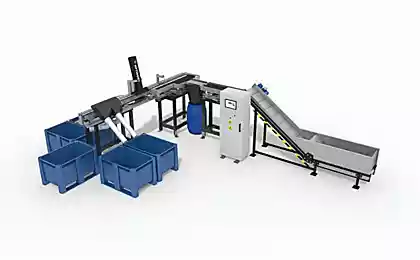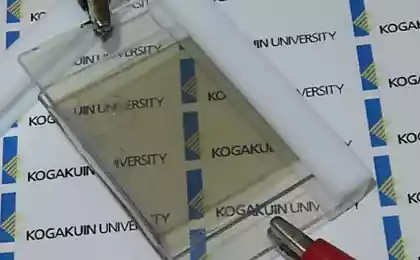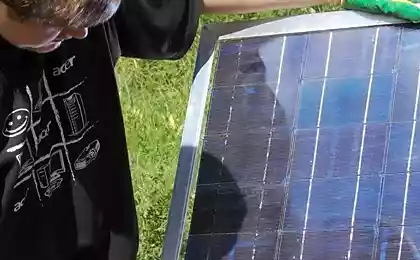238
Five Batteries for Tomorrow’s Technology
February 18, 1745 in the Italian town of Como was born Alessandro Giuseppe Atonio Anastasio Gerolamo Umberto Volta – the future inventor of the first chemical source of electric current.
Interested in researching “animal electricity” Galvani, Alessandro Volta does many experiments, the result of which, eventually, becomes his famous "volt pole" - electric battery. And Volta called his first battery a “crown of cups” – he put several cups filled with a heated solution of salt in a circle. In each of them he dropped plates of different metals. The plates of adjacent cups were connected by copper wires... but it was very impractical. And so in 1799, in the laboratory of Volta, an extremely technological and reliable design of a source of direct electric current - volts of poles - was born, in today's language.
Here is how he describes his invention: I put on a table or on some support one of the metal plates, for example, silver, and on it a zinc and then a wet disk, etc. in the same order. Zinc should always follow silver or vice versa, depending on their location in the first pair, and each pair is shifted by a wet disk. In this way I build up from these floors a pillar of such height that it can hold without falling down.” A variety of combinations of metals were tested, and it turned out that the best "work" mugs of copper and zinc, between which a cardboard pad impregnated with potassium alkali is placed.
Funny: one of the first consumers of the "voltaic pole", which created a voltage of 60 - 70 V, were doctors who treated their patients with discharges of electric stingrays. The stingrays were in short supply, and those who want to undergo the procedure - at least plenty. In England, patients paid between 2 and 12 shillings per shock. Of course, "volts pillar" went "hurrah" ... By the way, when in 1801 he came to Paris to demonstrate to Napoleon Bonaparte his electrical experiments, his main invention was called: "Artificial electric organ mimicking the natural electric organ of an eel or stingray." The demonstration of the experiments made Napoleon delighted. He ordered the minting of a medal in honor of Volta, the establishment of a prize of 80 thousand ecu, and later awarded Volta the title of count and made him a member of the Royal Senate of Italy.
In a sense, Alessandro Volta can be compared to a climber who, somewhere up there, pushed down a pebble, causing a huge avalanche. An avalanche of discoveries, inventions, technologies made possible by a simple circumstance: a reliable source of electricity appeared in the hands of researchers. Everything else, as they say, is a matter of talent and technique. Today, on Alessandro Volta's birthday, let's take a look at what his current successors are doing 269 years later.
1. The smallest battery.
This development of a group of researchers at Sandia National Laboratory (USA) led by Jianyu Huang (pictured below) is not yet considered as a prototype of any product, but allows you to get an idea of the possible densities of energy stored in lithium batteries.
The smallest of the existing lithium-ion batteries was made on the basis of nanofibers of tin oxide (cathode) and cobalt oxide (anode). Using the translucent electron microscope of the Center for Nanotechnology of the U.S. Department of Energy, the researchers were able to observe in real time the processes of introduction of lithium ions into the crystal lattice of the nanoelectrode and make sure that the nanofibers are able to withstand enormous mechanical stresses (more than 10 GPa) during saturation with lithium. The world’s smallest wire battery has dimensions: 10 μm long and 100 nm diameter. The operating voltage is 3.5 V, with a current of the order of picoamperes.
2. Battery printing
“Print” on a 3D printer tiny lithium-ion battery smaller than 1 mm managed recently a group of researchers at Harvard and Illinois universities. A special printing head with a 30 μm diameter hole formed layers of electrodes at a rate of 1 millimeter per second.
The battery cathode is a lit iron phosphate, the anode is lithium titanate. During the experiments, a workable battery sample was made, placed in a plastic case containing a tiny drop of electrolyte (pictured below).
3. Pure organics...
From the smallest batteries, let’s move on to the giant designs of the latest so-called “flow batteries” (pictured below – one of these devices), designed to store energy generated by solar plants, wind generators and power plants using the energy of ocean tides. The main idea of this type of batteries is to store energy not in electrodes, but in an electrolyte, which opens up the fundamental possibility of creating energy storage for almost any capacity.
The latest news from the field of these technologies is associated with the creation of flow batteries that use electrochemical reactions in the environment of organic compounds. More recently, a group of scientists at Harvard University led by Michael Aziz launched a flow battery based on an aqueous solution of quinones (the researchers joke: these substances are akin to those with which the rhubarb plant is so rich).
The main advantage of the new organic battery design over the existing ones is a significant reduction in unit cost. While traditional inorganic electrolyte-powered streamers cost about $700/kWh, the new Harvard battery is priced at just $27/kWh.
4. Startups are coming...
Last year alone, more than a dozen start-ups in the United States received more than $1.5 million in funding to create new types of chemical current sources. What are they working on now? Well, here's one.
Startup Ambri Professor at the Massachusetts Institute of Technology Don Sadoway is developing a direction in which it is planned to create a new type of battery, which uses electrodes made of liquid metal and molten salt electrolyte.
Imprint Energy is working hard to create ultra-thin, paper-flexible batteries manufactured using screen printing technology. These devices will use zinc instead of lithium. The main consumers of the new batteries will reportedly be wearable medical devices. In the photo below - a "thicker" analogue of this development from Apple.
Funded by the U.S. ARPA-E program, Pellion has set its sights on a total overhaul of all possible battery cathode materials capable of working with a magnesium anode. For this purpose, a special computer simulation program has been created, which should analyze more than 10,000 possible electrochemical pairs.
The company Prieto Battery, created by Professor Aimee Prieto, intends to release a new lithium-ion battery based on copper nanowires (anode) and a solid polymer electrolyte, which will be able to charge in 5 minutes, having a capacity 5 times higher than the current one.
5. And the smell of sulfur...
A battery of record energy consumption based on an unusual electrochemical pair “lithium – sulfur” was created at the Lawrence National Laboratory in Berkeley. If a conventional lithium-ion battery has a specific capacity of about 200 Wh / kg, then the new lithium-sulfur battery this figure reaches 350 - 400 Wh / kg. In the case of using this battery in an electric car, its range will be about 450 - 500 km without recharging (against 180 - 250 km on lithium-ion of the same mass).
The new battery is also capable of withstanding approximately 1,500 charge-discharge cycles, which is 1.5 times higher than that of lithium-ion. Such remarkable characteristics were achieved, among other things, due to the use of a new composite anode based on a graphene-sulfur bundle.
Source: compulenta.computerra.ru/
Interested in researching “animal electricity” Galvani, Alessandro Volta does many experiments, the result of which, eventually, becomes his famous "volt pole" - electric battery. And Volta called his first battery a “crown of cups” – he put several cups filled with a heated solution of salt in a circle. In each of them he dropped plates of different metals. The plates of adjacent cups were connected by copper wires... but it was very impractical. And so in 1799, in the laboratory of Volta, an extremely technological and reliable design of a source of direct electric current - volts of poles - was born, in today's language.
Here is how he describes his invention: I put on a table or on some support one of the metal plates, for example, silver, and on it a zinc and then a wet disk, etc. in the same order. Zinc should always follow silver or vice versa, depending on their location in the first pair, and each pair is shifted by a wet disk. In this way I build up from these floors a pillar of such height that it can hold without falling down.” A variety of combinations of metals were tested, and it turned out that the best "work" mugs of copper and zinc, between which a cardboard pad impregnated with potassium alkali is placed.
Funny: one of the first consumers of the "voltaic pole", which created a voltage of 60 - 70 V, were doctors who treated their patients with discharges of electric stingrays. The stingrays were in short supply, and those who want to undergo the procedure - at least plenty. In England, patients paid between 2 and 12 shillings per shock. Of course, "volts pillar" went "hurrah" ... By the way, when in 1801 he came to Paris to demonstrate to Napoleon Bonaparte his electrical experiments, his main invention was called: "Artificial electric organ mimicking the natural electric organ of an eel or stingray." The demonstration of the experiments made Napoleon delighted. He ordered the minting of a medal in honor of Volta, the establishment of a prize of 80 thousand ecu, and later awarded Volta the title of count and made him a member of the Royal Senate of Italy.
In a sense, Alessandro Volta can be compared to a climber who, somewhere up there, pushed down a pebble, causing a huge avalanche. An avalanche of discoveries, inventions, technologies made possible by a simple circumstance: a reliable source of electricity appeared in the hands of researchers. Everything else, as they say, is a matter of talent and technique. Today, on Alessandro Volta's birthday, let's take a look at what his current successors are doing 269 years later.
1. The smallest battery.
This development of a group of researchers at Sandia National Laboratory (USA) led by Jianyu Huang (pictured below) is not yet considered as a prototype of any product, but allows you to get an idea of the possible densities of energy stored in lithium batteries.
The smallest of the existing lithium-ion batteries was made on the basis of nanofibers of tin oxide (cathode) and cobalt oxide (anode). Using the translucent electron microscope of the Center for Nanotechnology of the U.S. Department of Energy, the researchers were able to observe in real time the processes of introduction of lithium ions into the crystal lattice of the nanoelectrode and make sure that the nanofibers are able to withstand enormous mechanical stresses (more than 10 GPa) during saturation with lithium. The world’s smallest wire battery has dimensions: 10 μm long and 100 nm diameter. The operating voltage is 3.5 V, with a current of the order of picoamperes.
2. Battery printing
“Print” on a 3D printer tiny lithium-ion battery smaller than 1 mm managed recently a group of researchers at Harvard and Illinois universities. A special printing head with a 30 μm diameter hole formed layers of electrodes at a rate of 1 millimeter per second.
The battery cathode is a lit iron phosphate, the anode is lithium titanate. During the experiments, a workable battery sample was made, placed in a plastic case containing a tiny drop of electrolyte (pictured below).
3. Pure organics...
From the smallest batteries, let’s move on to the giant designs of the latest so-called “flow batteries” (pictured below – one of these devices), designed to store energy generated by solar plants, wind generators and power plants using the energy of ocean tides. The main idea of this type of batteries is to store energy not in electrodes, but in an electrolyte, which opens up the fundamental possibility of creating energy storage for almost any capacity.
The latest news from the field of these technologies is associated with the creation of flow batteries that use electrochemical reactions in the environment of organic compounds. More recently, a group of scientists at Harvard University led by Michael Aziz launched a flow battery based on an aqueous solution of quinones (the researchers joke: these substances are akin to those with which the rhubarb plant is so rich).
The main advantage of the new organic battery design over the existing ones is a significant reduction in unit cost. While traditional inorganic electrolyte-powered streamers cost about $700/kWh, the new Harvard battery is priced at just $27/kWh.
4. Startups are coming...
Last year alone, more than a dozen start-ups in the United States received more than $1.5 million in funding to create new types of chemical current sources. What are they working on now? Well, here's one.
Startup Ambri Professor at the Massachusetts Institute of Technology Don Sadoway is developing a direction in which it is planned to create a new type of battery, which uses electrodes made of liquid metal and molten salt electrolyte.
Imprint Energy is working hard to create ultra-thin, paper-flexible batteries manufactured using screen printing technology. These devices will use zinc instead of lithium. The main consumers of the new batteries will reportedly be wearable medical devices. In the photo below - a "thicker" analogue of this development from Apple.
Funded by the U.S. ARPA-E program, Pellion has set its sights on a total overhaul of all possible battery cathode materials capable of working with a magnesium anode. For this purpose, a special computer simulation program has been created, which should analyze more than 10,000 possible electrochemical pairs.
The company Prieto Battery, created by Professor Aimee Prieto, intends to release a new lithium-ion battery based on copper nanowires (anode) and a solid polymer electrolyte, which will be able to charge in 5 minutes, having a capacity 5 times higher than the current one.
5. And the smell of sulfur...
A battery of record energy consumption based on an unusual electrochemical pair “lithium – sulfur” was created at the Lawrence National Laboratory in Berkeley. If a conventional lithium-ion battery has a specific capacity of about 200 Wh / kg, then the new lithium-sulfur battery this figure reaches 350 - 400 Wh / kg. In the case of using this battery in an electric car, its range will be about 450 - 500 km without recharging (against 180 - 250 km on lithium-ion of the same mass).
The new battery is also capable of withstanding approximately 1,500 charge-discharge cycles, which is 1.5 times higher than that of lithium-ion. Such remarkable characteristics were achieved, among other things, due to the use of a new composite anode based on a graphene-sulfur bundle.
Source: compulenta.computerra.ru/























